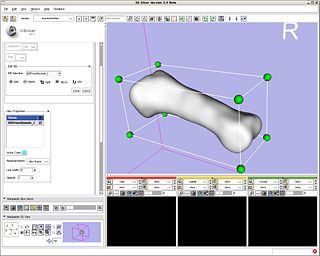2008 Winter Project Week:Finite Element Meshing into NA-MIC
 Return to 2008_Winter_Project_Week |
Key Investigators
- University of Iowa: Nicole Grosland , Vince Magnotta, Kiran Shivanna, Srinivas Stadepali
- Isomics: Steve Pieper, Curtis Lisle
- Kitware: Brad Davis
Objective
The University of Iowa has developed a complete Finite Element meshing workflow to operates from image source through to FE simulation using Abaqus. For this project, these standalone tools are being extended and also integrated as a module in Slicer3 to bring Finite Element modeling into the NA-MIC toolkit. Software is being developed for interactive editing of mesh bounding boxes and mesh quality visual feedback. The Slicer3 infrastructure is being extended to support Unstructured Grid datatypes for meshing processes, and the functions from the Univ. of Iowa workflow are being incorporated incrementally during the course of this project.
Approach, Plan
Throughout this project, we follow the process of developing standalone applications to address the problem first, then adapt them for deployment in the NA-MIC toolkit.
During the January 2008 Project Week, we plan to discuss the lessons learned through the first prototype integration of standalone algorithms into a Slicer3 module. Since this project and the EM Segmenter both have workflows to automate, we will share experiences.
At the end of the week, our objective is to have the FE workflow from surface->bounding box -> mesh working in Slicer3 using MRML storage for the intermediate steps.
Progress
Jan 2007 Project Week
During this half-week, we refined algorithms to render meshes interactively and provide quick feedback on the quality of mesh elements. We discussed the workflow designed at Univ. of Iowa and how it could be incorporated into Slicer3.
June 2007 Project Week
During this Project Week, we completed a prototype command line module for Slicer3 displaying FE mesh element quality. We also discussed how to add VTK 3D widgets into Slicer and implemented a new MRML node for widgets as a learning exercise for MRML tree interaction. We decided not to follow through with Widgets as first class objects in MRML. Instead, the associated data (e.g. a mesh bounding box) will have a MRML node.
Jan 2008 Project Week
The implementation of all intermediate steps and intermediate data products (surface, build block datastructure, mesh seeds, and final mesh) using storage in MRML is largely complete. Some design re-write to improve future coding speed is necessary, but techniques are flushed out and working using MRML storage.
References
- P.P. Pebay, D. C. Thompson, J. Shepherd, P. Knupp, C. R. Lisle, N. M. Grosland, V. A. Magnotta, ,*New Applications of the Verdict Library for Standardized Mesh Verification", Proceedings of the International Meshing Roundtable (IMR 2007), Seattle, WA, October 2007
